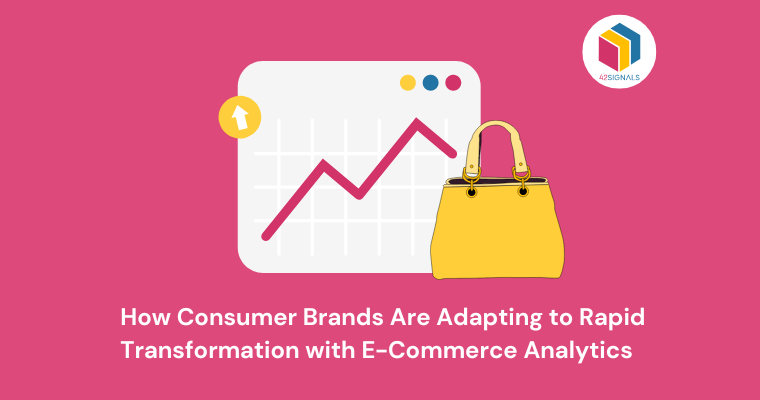Table of Contents
ToggleAn online store is equally important for established and newcomer consumer brands as a brick-and-mortar store. By 2028, Forrester expects US offline retail sales to reach $4.2 trillion and account for 72% of the market. Forecasts estimate that by 2027the online segment will make up close to a quarter of total global retail sales.
With more consumers shopping online than ever, it has become crucial for brands to adapt to this new landscape by leveraging data analytics to optimize their e-commerce efforts. Let’s explore how leading consumer brands are embracing digital transformation through e-commerce analytics.
What is E-Commerce Analytics?
Firstly, let’s define what we mean by “e-commerce analytics.” Essentially, e-commerce analytics refers to the process of analyzing customer behavior and sales data from online channels to make informed business decisions. By using tools such as web analytics, social media monitoring, and conversion rate optimization, consumer brands can gain valuable insights into their customers’ preferences, purchasing habits, and pain points.
Companies Adapting to Rapid Transformation
Nike
One example of a brand successfully adapting to the rapid digital transformation is Nike. The sportswear giant recognized early on that its target audience was increasingly turning to online platforms to research and purchase products. As a result, Nike invested heavily in developing a robust e-commerce strategy, including creating personalized experiences for customers based on their browsing history and previous purchases.

Image Source: Saithru
They also used data analytics to identify popular product categories and regions, allowing them to tailor their inventory accordingly. These efforts paid off, with Nike reporting a 36% increase in digital sales.
Sephora
Another company making waves in the world of e-commerce analytics is Sephora. Known for its innovative approach to beauty retail, Sephora uses data analysis to create highly targeted marketing campaigns.
For instance, they analyze customer reviews and ratings to determine which products should be featured prominently on their website or promoted via email campaigns. Additionally, Sephora offers loyalty program members exclusive access to personalized recommendations based on past purchases and browsing activity. Through these initiatives, Sephora has managed to build a loyal following among digitally savvy shoppers.

Image Source: WWD
Warby Parker
But it’s not just large corporations reaping the benefits of e-commerce analytics; small businesses can also leverage these tools to compete effectively in the online marketplace. Take Warby Parker, for example – the eyewear brand started as an exclusively online retailer but quickly gained popularity due to its home try-on service and stylish yet affordable frames.

Image Source: Business Insider
To further enhance the customer experience, Warby Parker implemented a virtual try-on feature powered by augmented reality technology. By analyzing user feedback and engagement metrics, they were able to refine this tool and improve overall satisfaction rates.
So how can your brand begin harnessing the power of e-commerce analytics? Here are some tips:
How E-Commerce Analytics Help Consumer Brands
1. Invest in the e-commerce right tools
There are numerous e-commerce analytics solutions available, ranging from free options like Google Analytics to more advanced platforms such as Adobe Analytics or Mixpanel. Choose one that fits your budget and meets your specific needs.
- Research various e-commerce analytics solutions to find the best fit for your business needs and budget. Consider factors such as ease of use, integration capabilities, scalability, and support services.
- Start with basic tools such as Google Analytics if you have limited resources. It provides essential features like traffic tracking, goal setting, and conversion measurement at no cost.
- Graduate to more advanced platforms when necessary. Options include Adobe Analytics, 42Signals, and Microsoft Clarity offering additional functionality like funnel visualizations, predictive analytics, and A/B testing.

2. Focus on key performance indicators (KPIs)
Identify the most important metrics for your business, such as conversion rate, average order value, or cart abandonment rate. Regularly track these KPIs to gauge the effectiveness of your e-commerce strategy.
- Define relevant KPIs for your business, considering both short-term goals and long-term objectives. Examples may include revenue growth, customer acquisition costs, customer lifetime value, or retention rates.
- Set up regular reports to monitor progress toward established KPI targets. Most analytics tools allow customizable dashboards and automated report generation.
- Establish benchmarks against industry standards or historical performance to assess improvements and areas requiring attention.
- Periodically review your KPIs and adjust them according to changing business priorities or market conditions.
3. Segment your audience
Don’t treat all customers as equals. Use demographic, geographic, and behavioral data to segment your audience into distinct groups, then tailor your marketing messages and promotions accordingly.
- Collect and organize customer data from multiple sources, such as web analytics, CRM systems, or social media platforms. Integration with third-party tools might be required for seamless data flow.
- Create segments based on common characteristics, such as location, age group, gender, device type, or browsing behavior.
- Tailor marketing messaging, promotional offers, or product recommendations to resonate with each segment. Be mindful of legal requirements regarding privacy and consent when handling sensitive information.
- Monitor the success of segment-specific tactics and adjust them as needed based on customer response and feedback.
4. Test and iterate
Continuously experiment with different elements of your e-commerce platform, such as page layouts, product descriptions, or pricing structures. Analyze the results of each test to inform future adjustments.
- Develop hypotheses about potential improvement opportunities within your e-commerce platform. Ideas could stem from user feedback, competitor analysis, or industry trends.
- Implement controlled experiments, isolating variables to measure the impact of changes accurately. Common methods include A/B testing, multivariate testing, or usability studies.
- Document findings from each test, highlighting significant outcomes and lessons learned. Share these insights with relevant stakeholders to foster continuous learning and innovation.
- Prioritize follow-up actions based on test results, allocating time and resources efficiently while maintaining focus on core business functions.
5. Personalization is key
Leverage data analytics to offer personalized recommendations, discounts, or content to individual customers based on their browsing history and purchasing patterns.
- Gather data about customer preferences, behaviors, and interactions across touchpoints. Combine first-party data from your systems with second-party or third-party data sources for comprehensive views.
- Employ machine learning algorithms or recommendation engines to suggest personalized product recommendations, special deals, or contextually relevant content.
- Utilize dynamic content insertion techniques to display tailored messages or images depending on user attributes. Popular applications include greeting users by name, recommending items similar to previously viewed ones, or presenting locale-specific promotions.
- Evaluate the effectiveness of personalization efforts regularly, measuring metrics such as click-through rates, conversions, or customer satisfaction scores. Refine approaches based on quantitative and qualitative feedback.
Conclusion
For consumer brands today online sales are as important as offline ones – if not more. With the right strategies and tools, newcomer and older businesses can adopt e-commerce analytics and see several improvements.
If you’re interested in an e-commerce analytics tool, check out 42Signals. Our platform provides granular insights into competitor strategies and customer data, leading the way for product and marketing improvements.
Start a free trial today.




